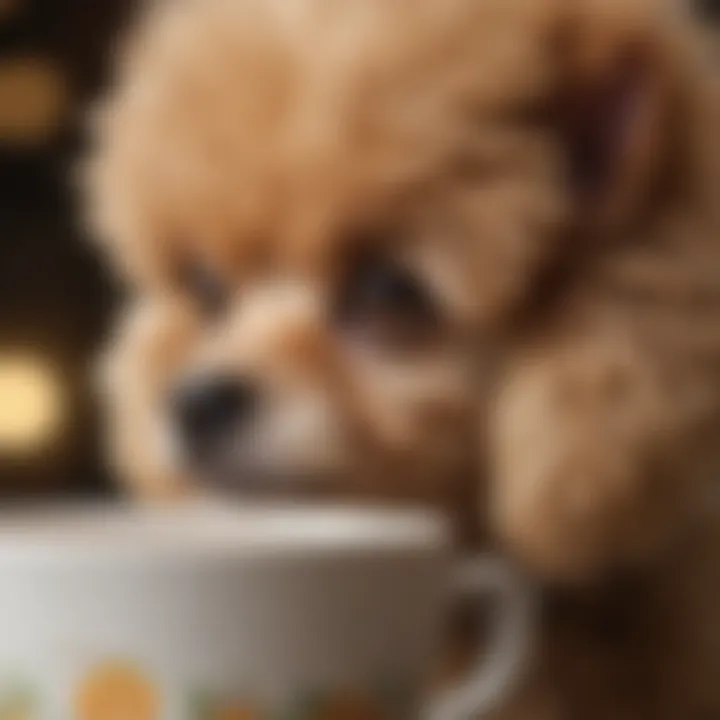Teacup Poodle Mixed Breeds: Traits and Ownership Tips


Intro
Teacup Poodles are more than just a charming face; they possess a unique blend of characteristics making them an appealing option for various pet owners. When mixed with other breeds, these tiny poodles forge delightful personalities that might win your heart. Understanding the blend of traits these little dogs offer, along with their health needs and care routines, can significantly enhance your experience as a pet owner.
Mixed breeds often bring the best of both worlds, but the combinations can be as varied as they come. Each mix presents an opportunity to discover new quirks and characteristics, some of which might be quite different from their teacup poodle parent. This exploration will delve into what you can expect from owning a teacup poodle mix and what it entails to be a responsible pet owner who prioritizes their furry companion's wellbeing.
Pet Care and Grooming
Pet care is crucial for the well-being of any dog, but when it comes to teacup poodle mixes, attention to grooming and care takes on a particular significance due to their delicate physicality. Maintaining their health involves regular grooming, tailored nutrition, and training that nurtures both body and mind.
Importance of Regular Care
The first aspect to consider with teacup poodle mixes is the routine care they need to thrive. Regular grooming not only keeps them looking their best but also plays a role in their health. Mats can develop easily in their fur, leading to skin irritations if neglected. Their small stature means that extra care needs to be taken to ensure they don't accidentally injure themselves during play or grooming.
Grooming Techniques by Pet Type
Different mixes may have different grooming needs. For instance, a teacup poodle mixed with a Shih Tzu may inherit a thicker, curlier coat compared to a teacup poodle mixed with a Chihuahua. Here's a look at some grooming techniques tailored by mix type:
- Poodle-Chihuahua: Often, their coats are short and require minimal brushing, but regular baths can help keep them fresh.
- Poodle-Shih Tzu: This mix might require more frequent grooming sessions, incorporating a slick brush to keep tangles at bay.
- Poodle-Yorkie: A combination that often results in a longer, silkier coat. Brush daily to avoid mats.
Tools and Products Recommendations
For effective grooming, invest in some decent quality tools:
- Slicker brush for detangling.
- Pet-safe shampoo for gentle cleaning.
- Nail clippers to maintain nail health.
- Ear cleaner solution, as small dogs can have issues with ear hygiene.
Seasonal Care Tips
Seasons can change the way you care for your teacup poodle mix. In colder months, consider protective wear to keep them warm during walks. Conversely, during hotter months, ensure they have plenty of water and limit outdoor time during peak sun hours to prevent overheating.
"A well-groomed dog is not only a joy to behold but also a healthier companion."
Health and Nutrition
Nutrition plays a pivotal role in the life of any small breed, and teacup poodle mixes are no exception. They require a well-rounded diet that suits their unique needs.
Understanding Pet Nutrition
Pets need a balanced diet just like we do. Focus on high-quality dog food that incorporates the right mix of protein, fats, vitamins, and minerals. Teacup poodle mixes, due to their smaller size, need food tailored for small breeds, often higher in calories to support their energy levels.
Common Health Issues by Species
Certain health concerns are more prevalent among teacup poodle mixes. Watch out for:
- Dental issues: Small breeds often suffer from dental disease, so regular brushing or dental chews are essential.
- Patellar luxation: This is a common issue that can lead to pain or mobility problems.
- Hypoglycemia: Particularly in smaller pups, low blood sugar can become a serious concern, so frequent meals with nutritious snacks can help.
Preventive Care and Regular Check-Ups
Regular check-ups with your veterinarian cannot be overstated. These visits are vital in catching potential health issues early and maintaining your pet’s well-being.
Food and Dietary Advice
When selecting food for your teacup poodle mix, read the ingredients carefully. Look for real meat as the first ingredient, and avoid fillers that might contribute no nutritional value. Additionally, consider speaking with your vet for tailored dietary advice based on your pup’s unique needs.
Behavioral Training
Training is more than just teaching your teacup poodle mixed breed tricks; it establishes a solid foundation for behavior and helps create a harmonious home.
Basics of Positive Reinforcement
Positive reinforcement is key when training dogs. This method involves rewarding good behavior with treats, praise, or playtime, encouraging them to repeat those actions. It also strengthens your bond with your pet, laying groundwork for trust.
Training Techniques Users Can Apply
Few techniques can be highly beneficial for small breeds like teacup poodles:
- Clicker training: It can help your dog associate sound with receiving a treat, which enhances learning.
- Short training sessions: Given their breed, aim for shorter sessions to maintain focus.
Managing Behavioral Issues
Behavior problems can arise from anxiety or lack of training. Observe your dog's body language and intervene if they seem stressed or uncomfortable. Also, ensure they have enough mental stimulation, which can help reduce unwanted behaviors.
Importance of Socialization
Lastly, socializing your teacup poodle mix is crucial. Introduce your pup to various environments, people, and other pets. Doing so helps them grow into a well-adjusted dog capable of facing different situations.
Engaging Activities and Enrichment
Keeping your teacup poodle mix mentally and physically stimulated is fundamental. Engaging activities can prevent boredom and create a more well-rounded pet.
Fun Games to Play with Your Pet
Here are a few engaging games:
- Hide and Seek: Dogs love this game, and it encourages them to use their noses.
- Tug-of-War: Great for bonding and provides a good outlet for energy.
DIY Toys and Activities
Creating DIY toys can be both fun and practical. A simple braided rope made from old t-shirts can make for a good tug toy. Use safe materials and supervise your pet to ensure their safety.
Importance of Mental Stimulation
Mental exercises are just as important as physical ones. Puzzle toys or treat-dispensing toys can keep your pooch occupied.


Outdoor Adventures and Exploration
Going for walks or hikes not only promotes physical health but also exposes your teacup poodle mix to varied environments and sights, stimulating their senses and satisfying their curiosity.
Resources and Community Engagement
In the age of information, numerous community resources can enhance your pet ownership experience. Here's where to look:
Recommended Books and Websites
Consider reading up on care specifically for poodle mixes:
- "The Complete Poodle Handbook"
- Websites like Wikipedia and Britannica offer extensive information.
Forums and Groups for Pet Owners
Online forums and community groups can be invaluable for exchanging tips and experiences. Check out Reddit threads on teacup poodle discussions.
Finding Local Services and Classes
Seek out local dog trainers and grooming services. Many offer classes specifically designed for small breeds.
Encouraging Community Sharing and Contributions
Encouraging sharing of experiences within communities can bolster support for pet owners. Consider blogging or posting about your journey, as it fosters connections and shares valuable insights.
By digging deep into the characteristics and overall care needed for teacup poodle mixes, hopeful owners can find that sweet spot of knowledge that leads to a fulfilling partnership with their next furry friend.
Prelims to Teacup Poodle Mixed Breeds
The world of dogs is vast and varied, but few breeds capture the imagination quite like the teacup poodle mixed breeds. As we explore this topic, it becomes clear that understanding teacup poodles and their mixes goes beyond mere aesthetics. There's a tapestry of history, characteristics, and behavioral insights that paint a fuller picture of these delightful companions.
Teacup poodles, as the name suggests, are pint-sized versions of standard poodles. Renowned for their intelligence and playful nature, they make for not just charming pets but also loyal companions. However, buying a teacup poodle mix is not just a transaction; it comes with responsibilities and considerations that prospective pet owners must weigh thoughtfully.
Definition of Teacup Poodles
Teacup poodles are essentially a smaller variation of the poodle breed, typically weighing no more than 5-7 pounds. Unlike standard or miniature poodles, these tiny dogs are bred specifically to be even smaller, resulting in a size that appeals to those who favor portability and companionship rather than a larger canine presence. While the exact standards can differ from one breeder to another, the term "teacup" generally describes poodles who are substantially smaller than the miniature poodle size.
Many believe that this type of poodle has all the desirable traits of traditional poodles—such as intelligence, trainability, and hypoallergenic fur—packed into a more compact form. However, this size also brings about unique considerations, especially regarding their health and longevity.
History and Origins
The origins of the teacup poodle mixed breed can be traced back to the fascination humans have with tiny dogs. While poodles themselves can be traced back to Germany and France as water retrievers, the teacup variation was born out of a desire to create the ultimate lapdog. Originally, breeders would selectively breed smaller poodles to achieve this size, but it remains a topic of debate among dog enthusiasts whether this practice is entirely safe.
Over time, the teacup poodle became increasingly popular, especially within urban settings where space is at a premium. People began to see them as not just pets but fashion accessories, often adorning clothing and participating in pet shows. Alongside this rise in popularity came the introduction of various mixes; teacup poodles can be combined with other small breeds—such as chihuahuas, maltese, or shih tzus—to create mixed breeds that retain the beloved traits of poodles while showcasing unique characteristics from their counterparts.
"When you’re looking at teacup poodle mixes, you’re not just choosing a dog; you’re choosing a lifestyle."
Understanding the historical context behind teacup poodle mixed breeds allows potential owners to appreciate not only their physical attributes but also the implications of their breeding and genetic health. By grasping this foundation, individuals can make informed decisions about which mix best fits their future companionship needs.
Common Teacup Poodle Mixes
Understanding common teacup poodle mixes is central to grasping the multifaceted world of these petite canines. Each mix combines the charming qualities of the teacup poodle with those of another breed, producing unique companions that can vary widely in temperament, appearance, and health needs. Exploring these mixes empowers potential dog owners to find a match that aligns with their lifestyle and preferences.
The benefits of considering a mixed breed are many. Hybrid vigor often results in hardier dogs, while the diverse traits can provide a unique personality that could be exactly what you're looking for.
Teacup Poodle and Chihuahua
Mixing a teacup poodle with a Chihuahua creates a delightful little dog, often referred to as a "Poochi." This mix tends to inherit the playful energy and confident demeanor of both parent breeds. Teacup Poochis usually weigh between four to eight pounds and can stand about six to ten inches tall.
Characteristic of this mix, you'll see a lively personality, with an affectionate nature. They are known to bond closely with their owners and can become overly attached, which could lead to separation anxiety if not managed. Additionally, having a teacup Poochi could give you a watchdog that barks but in a dainty way. However, their small size makes them delicate, and harsh handling is a no-go.
Teacup Poodle and Maltese
The teacup Poodle-Maltese blend, often called a "Maltipoo," scores high on the cuteness scale. This mix typically sports a silky, hypoallergenic coat that appeals to those with allergies. Weight ranges from five to ten pounds, and they can grow about eight to thirteen inches in height.
Maltipoos tend to have a cheerful demeanor, filled with love and intelligence, making them an excellent choice for families. They enjoy playtime yet can be mellow enough to curl up in your lap for a cozy evening. However, be prepared for regular grooming sessions due to their dense hair—keeping it tangle-free requires some effort.
Teacup Poodle and Shih Tzu
Crossing a teacup poodle with a Shih Tzu produces a "Shih-poo." This mix generally weighs between six to twelve pounds, and can reach heights of eight to twelve inches. Shih-poos often showcase a beautiful coat that can either lean towards the wavy curly of the poodle or the silky straight of the Shih Tzu.
Known for their pleasant disposition, Shih-poos are affectionate and gentle. They thrive in social settings, which makes them suitable companions for families. However, like many small breeds, they may display stubborn streaks during training. Patience and consistent methods will be your best tools.
Teacup Poodle and Yorkie
The combination of a teacup poodle and Yorkshire Terrier results in a charming small breed known as a "Yorkipoo." Generally, this mix will weigh anywhere from six to twelve pounds and stand about seven to fifteen inches tall. The Yorkipoo often showcases an appealing coat that is soft and hypoallergenic, a real plus for allergy-sensitive owners.
Yorkipoos are spirited and full of personality, often carrying a love for adventure within their tiny frames. They appreciate being the center of attention and thrive on social interaction. That said, they may also exhibit a tendency to bark, given their terrier heritage, so early training is essential to ensure a well-behaved companion.
In summary, common teacup poodle mixes offer a wealth of variety, making them appealing to a wide audience from families to singles. Understanding these mixes will guide prospective owners in selecting the ideal furry friend, tailoring their new pets to their unique lifestyles.
"Adopting a dog is an opportunity for a life-changing bond—understanding the mix can make that journey smoother."
\n
Physical Characteristics
Physical characteristics are essential when it comes to understanding teacup poodle mixed breeds. Knowing what to expect in terms of size, weight, coat types, and unique facial features can be significant for prospective pet owners. Each of these elements plays a vital role not only in the appearance of the dog but also in their general health, exercise requirements, and even their behavior. Since these dogs are small, identifying their physical needs can make a world of difference in ensuring they thrive in their environment.
Size and Weight Parameters
Teacup poodles are tiny, and their mixed breeds tend to follow suit, though size can vary depending on the other parent breed involved. Generally, these little pups weigh between 2 to 9 pounds and stand about 6 to 9 inches tall. However, the specifics can differ drastically. For instance, when mixed with a Chihuahua, the size may lean towards the lower end of that scale, while a mix with a Maltese might result in a slightly heavier dog.
This size flexibility can affect several factors, like housing conditions, where a compact apartment may suit a smaller teacup mix better. Make sure to do proper research on how much space these pups require. Another thing to keep in mind is that such tiny sizes also make them more prone to injuries, so vigilance is key.


Coat Types and Colors
The coat types and colors of teacup poodle mixes can be a delightful surprise. Most often, you'll find beautiful curly coats from the poodle side, which can lend itself well to mixes. The variations in texture and length can depend on the other breed. For instance, mixes with Shih Tzus may have longer, silkier fur while combinations with a Yorkshire Terrier could produce straight coats.
In terms of colors, teacup poodle mixes frequently display a vibrant array of shades, including traditional apricot, black, white, and cream. Some mixes may even showcase striking patterns. This variability can add a layer of personal preference for future owners. However, it's wise to consider that a coat requiring regular grooming can lead to higher maintenance, so be prepared for that responsibility.
Facial Features
Facial features play a massive role in the overall appeal of teacup poodle mixes. Typically, they inherit expressive and animated faces. Depending on the mix, they can boast big, sparkling eyes that say a thousand words, along with a short, slightly rounded muzzle that adds to their charm.
One should also pay attention to ear types; whether they are floppy or erect can affect the dog's likability and cuteness factor. For instance, a teacup poodle mixed with a Chihuahua may have large ears that make it look even tinier. It's fascinating how different breeds create such unique visual appeal, but it is equally important to recognize that these features can impact health.
"Understanding a dog's physical traits is crucial for meeting its needs and ensuring a happy, healthy life."
Overall, the physical characteristics of teacup poodle mixed breeds give a solid foundation for embarking on a journey as a pet owner. From their size and weight to coat types and facial features, every aspect contributes to their charm and requirements. Educating oneself on these elements not only prepares future owners but also helps in creating an environment that supports a healthy and fulfilling life for these pint-sized companions.
Temperament and Behavior
Understanding the temperament and behavior of teacup poodle mixed breeds is crucial for potential pet owners. These small dogs have distinct personalities that can vary significantly based on their genetic background. Knowing what to expect can help you create a nurturing environment and foster a strong bond with your furry friend. A well-adjusted teacup poodle mix will not just be a pet but a true companion.
General Temperament Traits
Teacup poodle mixes often embody a mix of intelligence, energy, and affection from their poodle lineage. Generally, these pups are lively and playful, making them a delightful presence in any home. They thrive on interaction—be it through playtime, cuddling, or even simple companionship.
Here are some typical traits you might notice:
- Affectionate Nature: Most teacup poodle mixes are known for their loving disposition. They easily attach to their owners, often following them around the house as if shadowing them.
- Curiosity: These dogs are often full of curiosity. They explore their surroundings with zest, so keeping an eye on them during curious escapades is vital.
- Intelligence: Coming from a poodle background, teacup mixes inherit a sharp mind. They can learn commands quickly and often enjoy the challenge.
However, this same intelligence can lead to mischief if they are not properly stimulated. Providing toys that engage their minds is essential.
Socialization with Humans and Animals
Socialization plays a critical role in helping teacup poodle mixes develop well-rounded personalities. It's essential to expose them to various environments, people, and other animals from a young age. When they get a good dose of social experiences, it builds confidence and reduces fearful behaviors.
Encouraging positive interactions can lead to the following benefits:
- Comfort with New Experiences: When teacup poodles experience different situations early on, they are less likely to be apprehensive. This comfort can prevent anxiety-related behavior later in life.
- Developing Good Manners: Exposing them to friendly people and well-behaved animals teaches them how to interact amicably. They learn boundaries and respect, crucial traits for any dog.
- Enhanced Bonding: Socialization often strengthens the bond between you and your pet. Sharing new experiences can create lasting memories and trust.
Potential Behavioral Challenges
Even with the right upbringing, teacup poodle mixes may exhibit some behavioral challenges. Understanding these potential issues can help you address them positively. Here are a few common challenges to be aware of:
- Separation Anxiety: Being small and exceptionally attached to their owners, these dogs can suffer from separation anxiety, making them destructive if left alone for long periods.
- Barking Tendencies: Many teacup poodles have a tendency to bark. While it may help them communicate, excessive barking can become an annoyance. Identification of triggers is essential in managing this behavior.
- Training Resistance: Some teacup mixes might show a stubborn streak. They might resist commands, requiring more patience and inventive training techniques to keep them engaged.
By effectively managing these behavioral challenges through training and understanding, you can help cultivate a happy and well-adjusted companion who enhances your life.
"Understanding your dog's temperament is not just about knowing their quirks. It's about ensuring a happy life for both you and your cherished pet."
Health Concerns in Teacup Poodle Mixes
When considering the addition of a teacup poodle mix to your family, it’s crucial to take a hard look at their health concerns. These pint-sized companions may be adorable, but their small stature makes them more susceptible to a variety of health issues. Understanding these concerns helps potential owners prepare and avoid potential pitfalls. Moreover, informed pet ownership leads to better care and longer, healthier lives for these treasured pets.
Common Genetic Health Issues
Teacup poodle mixes, while charming, carry an array of genetic health challenges that can arise from their breeding. Some genetic issues common among these mixes include:
- Patellar Luxation: This is a fancy term for a dislocated kneecap. Teacup mixes often suffer from this due to their small bone structure, leading to discomfort and mobility issues.
- Dental Problems: Small breeds are prone to overcrowded teeth and gum diseases, which can result in painful extractions and costly dental care.
- Heart Conditions: Certain mixes, especially those with genetic predispositions, can face heart issues. Regular vet visits become paramount to monitor and manage these risks.
- Hypoglycemia: Low blood sugar can be an issue for teacup poodles, particularly if not fed on a regular schedule. Owners need to be vigilant about their eating habits.
By understanding these potential problems, new pet owners can seek out reputable breeders who screen their breeding dogs for genetic conditions before mate selection.
Preventive Care Strategies
The saying "an ounce of prevention is worth a pound of cure" holds particularly true for teacup poodle mixes. Taking proactive steps can prevent or mitigate some health issues.
- Regular Exercise: While they may be small, these dogs require daily walks and play sessions to keep their weight in check and promote cardiovascular health.
- Balanced Nutrition: Providing high-quality food tailored for small breeds is essential. Avoiding overfeeding is key to preventing conditions like obesity and its related issues.
- Dental Care: Establish a routine for brushing their teeth or provide dental chews suitable for small breeds. This can prevent tooth decay and gum disease.
- Training for Good Behaviour: Implementing basic commands and rules early on can help manage anxiety or behavior issues which can affect their health if they become too stressed.
These strategies can set the foundation for a long and healthy life, giving your poodle mix a running start.
Importance of Regular Vet Check-ups
Don’t wait for visible sickness before visiting the vet. Regular veterinary check-ups are crucial. As often said,
"A regularly scheduled check-up today could save your dog's life tomorrow."
- Early Detection: Many health problems are easier to manage when caught early. Routine check-ups can help identify conditions before they worsen.
- Vaccinations and Preventatives: Easily protect your pup from common diseases; keep those vaccination records up to date. This prevents a range of diseases that could harm your furry friend.
- Weight Management: Vets can assess your dog’s weight and diet, providing tailored advice to keep them fit and healthy.
- Health History: Documenting health progress through check-ups helps build a comprehensive history of your pet's health, which is invaluable down the line.
Being proactive and vigilant aids in navigating the potential health landscape of teacup poodle mixes. Pet ownership is a big responsibility, but with the right knowledge and care, it can also be highly rewarding.
Training and Socialization
Training and socialization are crucial elements for anyone looking to bring a teacup poodle mix into their lives. These small dogs are brimming with personality, but without proper guidance, their behavior can sometimes go awry. Training not only helps establish boundaries and good habits but also promotes a strong bond between the pet and owner. Socialization enables teacup poodle mixes to interact comfortably with humans and other animals, minimizing stress and anxiety in unfamiliar situations.
Training a teacup poodle mix is about teaching them the ropes and rewarding good behavior. It's essential to remember that these dogs are often quite intelligent, eager to please, and have a knack for learning new tricks. Given their small stature, their training may not be as physically demanding, but it requires consistency and patience.
"Consistency is the key. A little effort each day pays off big in the long run.”
Basic Training Techniques
When embarking on the journey of training a teacup poodle mix, consider employing several effective techniques:
- Positive Reinforcement: Always reward good behavior with treats or praises. This approach encourages them to repeat the action.
- Short Sessions: These dogs have relatively short attention spans, so keeping training sessions brief helps with retention.
- Command Familiarity: Use simple commands like "sit," "stay," and "come". Repeating them consistently will establish familiarity.
- Leash Training: Early leash training is important for small breeds. It helps in controlling them and preventing mishaps while out and about.
Training can also include variations like agility exercises, which can stimulate both their mind and body.
The Role of Socialization


Socialization is as important as training. Introducing your teacup poodle mix to various experiences, people, and environments helps in shaping their future behavior. Here are potent ways to foster socialization:
- Public Exposure: Take them to parks, pet-friendly stores, or community events. Gradually exposing them to crowds and sounds can lessen anxiety.
- Playdates: Arrange playdates with other dogs. This will teach them how to interact with their peers and improve their dog-to-dog communication skills.
- Routine Changes: Changing up your routine can also be beneficial. New walking routes or different types of walks cultivate confidence in unfamiliar territory.
Proper socialization sets a foundation for a well-adjusted animal, paving the way for enjoyable interactions and a happy lifestyle.
Common Challenges in Training
Despite the advantages of training and socialization, potential challenges can arise. Here are a few to keep an eye on:
- Stubbornness: Some teacup poodle mixes may exhibit a bit of stubbornness. Their small size might amplify behavioral issues, making it crucial to maintain a gentle yet firm approach.
- Fearfulness: If not socialized properly, they can become fearful and anxious in new situations. This can lead to aggressive behavior or extreme shyness.
- Over-excitement: When excited, these little dogs may expend energy in ways that aren’t always desirable, like excessive barking or jumping.
Having a comprehensive training and socialization plan in place can help mitigate these challenges, paving the way for a fulfilling and stable relationship between you and your teacup poodle mix.
Lifestyle Needs and Adaptations
Understanding the lifestyle needs and adaptations of Teacup Poodle mixed breeds is crucial for current and future pet owners. These dogs, with their delicate build and energetic spirits, have specific requirements that need to be met to ensure their well-being. If you're pondering over bringing one of these pint-sized companions into your life, knowing what they necessitate in terms of exercise, diet, and living conditions is non-negotiable. Each aspect plays a significant role in both their physical health and emotional satisfaction.
Exercise Requirements
Teacup Poodle mixes are small dogs but don’t let their size fool you; they have a fair amount of energy that needs to be burned off. A daily routine of light exercise is essential.
- Walking: A brisk stroll of about 30 minutes is ideal for keeping them fit. While it might seem minimal, this is vital for their muscle development and weight management.
- Playtime: Engaging in light, stimulating games like fetch or tug-of-war can uplift their spirits. They enjoy interactive play sessions, which not only provide physical exercise but also mental stimulation.
It’s worth noting that while these dogs may not need extensive exercise like larger breeds, consistent, gentle activity helps prevent behavioral issues. Remember, a worn-out dog is a happy dog!
Nutritional Needs
Feeding your Teacup Poodle mix requires special attention to their dietary needs. Because of their small stature, they generally need a diet that's rich in nutrients but low in calories.
- Quality Diet: Select high-quality dog food, ensuring it contains protein, healthy fats, and fiber. Look for brands that emphasize real meats and whole grains.
- Portion Control: Be mindful of the portion sizes. Small dogs are prone to overeating, which can lead to obesity—a significant concern in this breed.
- Fresh Water: Always ensure fresh water is available. Hydration helps keep their energy up and aids with digestion.
A balanced diet is not just about quantity; it’s about quality.
The right nutrition can help maximize the lifespan and health of your beloved Teacup Poodle mix, so taking time to choose wisely pays off in the long run.
Living Space Considerations
When it comes to housing, Teacup Poodle mixes are adaptable but still need a properly sized environment to thrive. Here’s what to keep in mind:
- Apartment Living: Their compact size makes them suitable for apartment living. Just ensure that the space is safe and devoid of hazards, like toxic plants or small objects they may swallow.
- Safe Zones: Create safe spaces within your living area. Small beds or blankets placed in quiet corners can create a sense of security for your pet.
- Outdoor Access: If you have a yard, make sure it’s securely fenced. Teacup Poodles can often get themselves into tricky situations, so having a safe outdoor space is a considerable benefit.
Bringing a Teacup Poodle mix into your home means you need to consider these lifestyle adaptations carefully. Understanding their exercise requirements, nutritional needs, and living space considerations ensures a happy and healthy life for your furry friend. With the right environment and care, you'll likely develop a bond that stands the test of time.
Selecting a Teacup Poodle Mix
Choosing a teacup poodle mix can feel a bit like trying to find a needle in a haystack. With so many options and considerations, it’s crucial to approach this decision thoughtfully. This process isn’t just about picking an adorable puppy; it also involves assessing compatibility with your lifestyle, understanding the breed’s unique traits, and ensuring that you’re ready for the responsibilities that come with pet ownership.
A major element to keep in mind when selecting a Teacup Poodle mix is the potential behavioral tendencies and health concerns associated with the breed. For instance, understanding the common characteristic traits of both parent breeds can help inform what you might expect. A teacup poodle mixed with a Chihuahua might showcase spirited energy, while a maltese mix could lean towards a more affectionate demeanor. These differences can influence your training strategies and overall home life.
Prospective owners should also consider their living environments. Teacup poodle mixes, while small, still require ample mental and physical stimulation. An active home with plenty of affection and engagement may suit a more energetic mix better than a quiet, laid-back setting. Understanding these dynamics is essential to ensure a harmonious living situation.
Moreover, adoption vs. purchase is another essential aspect. Reputable breeders often provide health guarantees and insights into the breeding practices, while adoption can give a chance to a dog in need of a loving home. This decision has lasting implications on the life of the pet you choose.
Reputable Breeders and Adoption
When it comes to finding a teacup poodle mix, establishing a strong foundation begins with reputable breeders or appropriate adoption channels. Not all breeders are created equal. Research is key here; seek out breeders who prioritize the health and wellbeing of their dogs over profit. A responsible breeder should provide a clean environment, allow you to meet the puppy’s parents, and offer documentation of health screenings.
Additionally, checking for reviews or feedback from past customers can provide insights into their practices. You can also consider adopting from shelters or rescues. Many teacup poodle mixes find themselves in need of homes, and giving one a second chance can be a fulfilling experience.
Assessing Temperament Before Purchase
Before a purchase or commitment is made, assessing temperament is vital. Each teacup poodle mix has its character, shaped largely by both genetics and individual personality. When visiting puppies, pay close attention to how they interact with you and their surroundings. Signs of curiosity, playfulness, or even shyness all provide clues.
It’s beneficial to ask about the puppy’s early socialization experiences; puppies that have been exposed to various settings and people are more likely to adapt well to new environments. Consider arranging a meet-and-greet with family members and pets to evaluate how the potential new addition reacts in your home. Connection is often about chemistry, and ensuring a good fit can save you heartache down the line.
Screening for Health Issues
Health screening is another regrettably overlooked aspect when considering a teacup poodle mix. Always inquire about health issues that could arise from the mix’s parent breeds. With smaller dog breeds like teacup poodles, certain genetic predispositions like dental problems or patellar luxation are worth understanding.
Request documentation regarding health clearances for both parents, which may include screenings for conditions such as hip dysplasia or eye disorders. Regular veterinary check-ups and a solid diet can mitigate some health risks, but knowing beforehand can guide you in managing potential issues.
In essence, selecting a teacup poodle mix is an extensive journey encompassing careful thought and attention to detail. By focusing on reputable sources, assessing temperament, and screening for health issues, prospective pet owners can make informed decisions. This diligence not only ensures a good match but ultimately contributes to a happier and healthier life for both the pet and the owner.
Ending: The Choice of a Teacup Poodle Mix
In this contemplation of the teacup poodle mixed breeds, we reach a pivotal juncture — the conclusion. Understanding the choice of a teacup poodle mix encompasses various dimensions that directly influence the lives of potential pet owners and their future companions. The allure of these petite pooches is undeniable, but with their charm comes a set of specific considerations that one must weigh carefully.
Weighing the Pros and Cons
When contemplating a teacup poodle mix, it's paramount to assess the benefits and drawbacks. Here are some crucial aspects to consider:
Pros:
- Compact Size: The small stature makes them ideal for apartments or homes with limited space.
- Affectionate Companionship: These mixes often form strong bonds with their humans, offering plenty of affection.
- Diverse Personalities: Each mix has unique traits, allowing owners to find a match that suits their lifestyle.
Cons:
- Health Vulnerabilities: Due to their size, teacup mixes can suffer from numerous health issues, including dental problems and heart issues.
- Sensitivity: These small dogs may be more sensitive to temperature changes and could require more supervision.
- Training Challenges: Sometimes, their spirited nature can lead to behavioral challenges that require consistent training and patience.
"Choosing the right pet is more than just picking a cute face; it's about understanding the full spectrum of responsibilities that come with that choice."
This balance of pros and cons can help guide an informed decision that aligns with one's lifestyle and ability to meet the dog's needs.
Long-term Commitment and Care
Acquiring a teacup poodle mix is not merely a fleeting whim; it is a long-term commitment that necessitates dedication and care. As these dogs can live for over a decade, potential owners must understand that their responsibilities will endure.
Here are a few considerations for long-term ownership:
- Regular Vet Visits: Keeping up with health check-ups is crucial, particularly given their predisposition to certain ailments.
- Quality Nutrition: A balanced diet tailored to their unique needs will promote their health and longevity.
- Mental and Physical Stimulation: These dogs, needing both mental challenges and physical exercise, thrive on activities that engage their innate curiosity.















